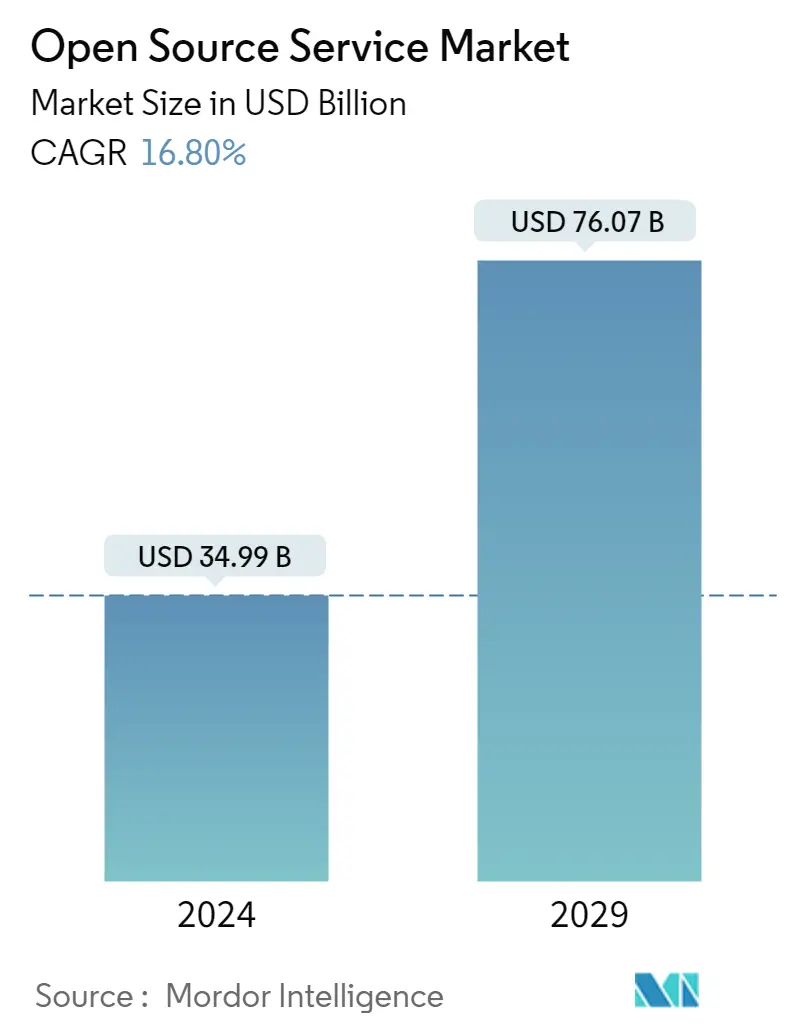Market Size of Open Source Service Industry

| Study Period | 2019 - 2029 |
| Market Size (2024) | USD 34.99 Billion |
| Market Size (2029) | USD 76.07 Billion |
| CAGR (2024 - 2029) | 16.80 % |
| Fastest Growing Market | Asia Pacific |
| Largest Market | North America |
Major Players
*Disclaimer: Major Players sorted in no particular order |
Open Source Service Market Analysis
The Open Source Service Market size is estimated at USD 34.99 billion in 2024, and is expected to reach USD 76.07 billion by 2029, growing at a CAGR of 16.80% during the forecast period (2024-2029).
While enterprise companies can benefit from the speed and flexibility of Open Source Service (OSS) tools to execute large-scale projects like digital transformation and data migrations, developers can start projects faster and with no initial cost outlay. These OSS allows working with a large group of developers who may be using the same tools or might have encountered similar problems and already have solutions to share.
- Everything from healthcare human resource management to medical wearables is powered by open source. Open source technology is ideal for use in the healthcare sector, where active collaboration between user and clinical communities and IT vendors allows for the development of solutions that maximize benefits to the provision of health and social care-according to a report released by the State of Open Source in June 2022, 77% of the businesses agreed that they adopted open-source software in the last year.
- Digital transformation and virtual connections became essential for organizations to survive as there was a shift for remote working post-Covid-19. Businesses adopted these free tools for a variety of tasks. According to Red Hat's State of Enterprise Open Source Report in 2022, 92% of IT leaders accepted that Open Source Services played an important role in shared solutions and crisis management during the challenging phase of the pandemic.
- Enterprises use various software assets from multiple sources, including internal, cloud, SaaS, and open source. They run anywhere and can be accessed via APIs and service calls from any location. APIs, serverless interfaces, vulnerable services, and opaque software assets contribute to the growing attack surface for these applications in this distributed environment. With the average company reporting 95% of API security incidents, APIs and service endpoints have emerged as preferred threat vectors. The number of security flaws involving APIs discovered in the OVE database between 2015 and 2021 increased by 540%. These factors may slow down the adaptation of the Open Source Service Market.
- During the ongoing COVID-19 pandemic, the demand for open-source service companies has seen an upward trend. Vendors in the market are using and expanding open source repositories containing datasets, models, visualizations, web and mobile applications, and more to innovate and build new solutions to combat the spread of the virus through generating awareness. For instance, Locale.ai created an open-source, interactive visualization of all known cases of COVID-19. The map provides live updates with new data as it becomes available.
Open Source Service Industry Segmentation
Anyone can view, modify, and distribute the code as they see fit in the Open Source Software. The software is created in a decentralized and collaborative manner, relying on peer review and community production that helps to use, change, and share source code with each other This scalable and adaptable software ensures that users having access to the source code can modify, improve, and redistribute it for more excellent reusability and accessibility. Programmers can use pre-existing code to enhance the software and even create new innovations. Ansible, Kubernetes, and Linux are well-known open-source projects.
The Open Source Service Market is Segmented By Service Type (Consulting and Implementation Services, Support, Maintenance, Management Services, Training Services), End-user Industry (Banking, Financial Services, Insurance, Telecom and IT, Manufacturing), and Geography.
The market sizes and forecasts are provided in terms of value (USD million).
| By Service Type | |
| Consulting and Implementation Services | |
| Support, Maintenance, and Management Services | |
| Training Services |
| By End-user Industry | |
| Banking, Financial Services, and Insurance | |
| Telecom and IT | |
| Manufacturing | |
| Government | |
| Healthcare | |
| Retail | |
| Others (Transportation and Logistics, Energy and Utilities) |
| Geography | ||||||
| ||||||
| ||||||
| ||||||
| Latin America | ||||||
| Middle East and Africa |
Open Source Service Market Size Summary
The Open Source Service Market is experiencing significant growth, driven by the increasing adoption of open-source technologies across various sectors. These services offer enterprises the agility and cost-effectiveness needed for large-scale projects such as digital transformation and data migrations. The healthcare sector, in particular, benefits from open-source solutions due to the collaborative nature of these technologies, which enhance the development of innovative healthcare solutions. The shift towards remote work post-COVID-19 has further accelerated the adoption of open-source tools, as businesses seek flexible and cost-effective solutions to maintain operations. Despite the advantages, the market faces challenges related to security vulnerabilities, particularly with APIs and service endpoints, which could hinder broader adoption.
The market is characterized by intense competition, with major players like Accenture, Oracle, Cisco, and Infosys leading the charge through strategic investments in research and development, partnerships, and acquisitions. These companies are leveraging open-source technologies to drive innovation in areas such as cloud-native applications, artificial intelligence, and machine learning. The North American region, home to many technology leaders, is at the forefront of this growth. Initiatives like the Open Compute Project and collaborations between companies such as Oracle and Red Hat are helping to standardize and enhance cloud operations. As open-source services continue to gain traction, they are poised to play a crucial role in shaping the future of technology across industries.
Open Source Service Market Size - Table of Contents
-
1. MARKET DYNAMICS
-
1.1 Market Overview
-
1.2 Industry Attractiveness - Porter's Five Forces Analysis
-
1.2.1 Bargaining Power of Suppliers
-
1.2.2 Bargaining Power of Buyers
-
1.2.3 Threat of New Entrants
-
1.2.4 Threat of Substitutes
-
1.2.5 Intensity of Competitive Rivalry
-
-
1.3 Impact of COVID-19 on Open Source Services Market
-
1.4 Market Drivers
-
1.4.1 Reduced Cost of Ownership and Time to Market
-
1.4.2 Interoperability and Flexibility in Terms of Customization
-
-
1.5 Market Restraints
-
1.5.1 Security Issues
-
-
-
2. MARKET SEGMENTATION
-
2.1 By Service Type
-
2.1.1 Consulting and Implementation Services
-
2.1.2 Support, Maintenance, and Management Services
-
2.1.3 Training Services
-
-
2.2 By End-user Industry
-
2.2.1 Banking, Financial Services, and Insurance
-
2.2.2 Telecom and IT
-
2.2.3 Manufacturing
-
2.2.4 Government
-
2.2.5 Healthcare
-
2.2.6 Retail
-
2.2.7 Others (Transportation and Logistics, Energy and Utilities)
-
-
2.3 Geography
-
2.3.1 North America
-
2.3.1.1 United States
-
2.3.1.2 Canada
-
-
2.3.2 Europe
-
2.3.2.1 United Kingdom
-
2.3.2.2 Germany
-
2.3.2.3 France
-
2.3.2.4 Rest of the Europe
-
-
2.3.3 Asia Pacific
-
2.3.3.1 China
-
2.3.3.2 Japan
-
2.3.3.3 India
-
2.3.3.4 Rest of the Asia Pacific
-
-
2.3.4 Latin America
-
2.3.5 Middle East and Africa
-
-
Open Source Service Market Size FAQs
How big is the Open Source Service Market?
The Open Source Service Market size is expected to reach USD 34.99 billion in 2024 and grow at a CAGR of 16.80% to reach USD 76.07 billion by 2029.
What is the current Open Source Service Market size?
In 2024, the Open Source Service Market size is expected to reach USD 34.99 billion.

